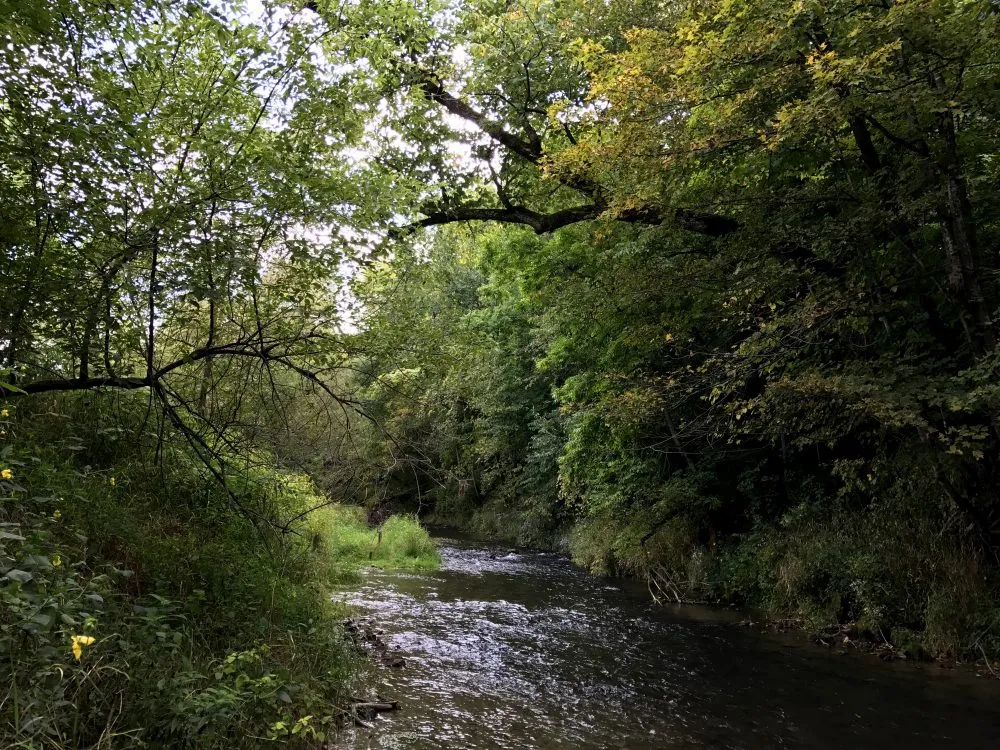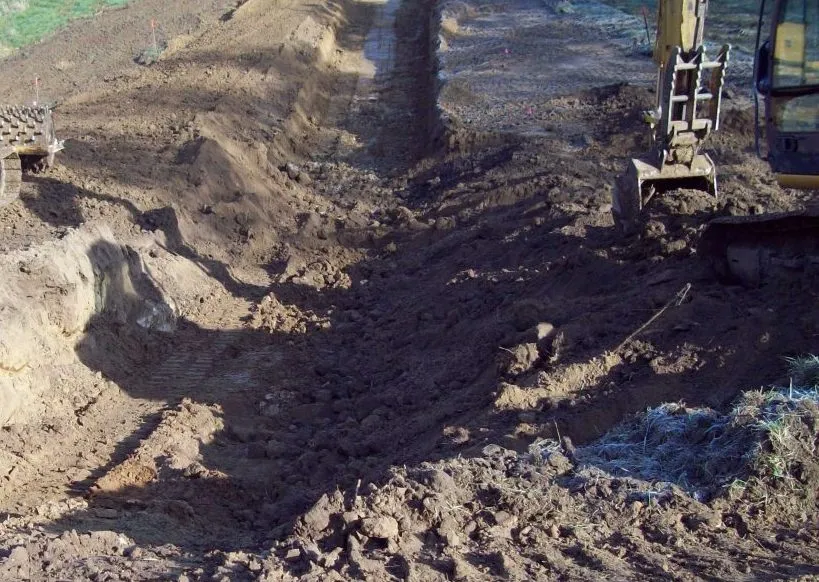Stories & Videos
Root causes, root solutions


Today, they ride trike in the calf barn, climb hay bales in pink cowboy boots, snuggle in a toddler-size John Deere sweatshirt. One day, Josh and Steph Dahl’s three children could become fifth-generation family farmers.
The Dahls are positioning their 160-cow Houston County dairy operation for the future with improvements made possible through the Root River Field to Stream Partnership. On their farm that means a 1.9 million gallon manure storage facility, a calf barn, heifer barn, and sediment control basins and waterways designed to reduce runoff and soil erosion.
Monitoring
The Dahls confidently invested in these projects after Root River Field To Stream Partnership conducted intensive edge-of-field and in-stream data collection to determine the effect specific conservation practices have on water quality.
Baseline monitoring started in 2010 on four farms within Houston, Fillmore and Mower counties. The venture led by Minnesota Department of Agriculture targets three small watersheds that drain into Root River tributaries. What is learned will apply to watersheds throughout southeastern Minnesota.
Farmers and federal, state and local agencies are working together to make this effort successful.

Field walk-overs
Forty-seven farmers in the project watershed agreed to field walk-overs to identify spots where conservation practices could benefit high-risk erosion areas. Ron Meiners, retired Root River Soil & Water Conservation District manager, started each field visit by noting the conservation practices already in place.
The walk-overs followed seven years’ monitoring that established baseline data. “This first phase is asking the question: What is the water quality like today under current farming practices and conditions?” said Preston-based Kevin Kuehner, the Minnesota Department of Agriculture soil scientist coordinating the partnership.

Within two years, more than 60 percent of the farmers who participated in field walk-overs had agreed to conservation fixes.
“We still have more work to be done, but that speaks volumes about the farmers’ commitment to be proactive and help improve water quality,” Meiners said.
Project implementation
Implementation started in July 2016. Projects on the Dahls’ farm were among more than 50 finished or under construction in the three watersheds during fall 2017.
Within Bridge Creek watershed, conservation practices implemented on the Dahls’ 450-acre farm south of Rushford had the greatest potential to improve water quality – partly because of the farm’s proximity to the creek.

“It was important to get that one addressed. Because you can do everything else in the watershed and if that’s still a source, it’s going to affect your outcomes of water quality,” said Donna Rasmussen, Fillmore SWCD district administrator. Fillmore SWCD is the fiscal agent for the Clean Water Fund grant.
Landowner experience
Josh Dahl said few surprises emerged during his field walk-over.
“We knew that our waterways were filling up and we knew that our manure storage was probably not the best, but we didn’t have the funds to do anything different,” Dahl said.
The farm had about five days’ worth of manure storage.
“Probably the worst has been when, during the winter, we would try to apply to our flattest ground up on top. If the roads were bad or the fields were especially muddy, we would just keep on applying to the same fields because we wouldn’t want to go on the steeper stuff. Then you would probably get some runoff,” Dahl said.

Dahl estimated his cost-share for all projects will total $200,000.
“We are very thankful for everything that has happened but it has been quite a process to get everything lined up. When you combine a federal project with a state project, you don’t necessarily always know who you should be talking with and how they are going to mesh together,” Dahl said. “It has been challenging at times.”
Water quality and community benefits
“There’s a huge investment of public dollars, but there’s a huge return to the public, too, as far as the water quality benefits,” Rasmussen said. “It’s not just the feedlot. It’s the other environmental benefits to keeping a small dairy on the land. They have hay in the rotation, so you have that filtering effect of hay strips on the land.”
The Dahl farm represents what Rasmussen would like to see replicated across the southeastern Minnesota landscape 10 years from now.
“I hope we see livestock on the land, that we have dairy farms and beef operations that are profitable and can maintain or provide income for families,” Rasmussen said. “For small communities to be strong, you need families with children, your school district needs to be strong, your churches need to be viable, and community building networks are needed to support families and people who live here.”

Focused approach
“The project answers ‘What if we can really target practices in strategic locations within these watersheds that have a high risk for runoff? What if we can get additional practices in those locations, and what effect might that have in the watershed?’” Kuehner said. “What’s the best we can do with a saturated, focused approach?”
Improvements on the Dahl farm were among 160 individual projects proposed across the three watersheds.
During the first two years after baseline testing, practices installed include more than 65,000 feet of waterway (10,000 additional planned for 2018), 11 structures (two more in 2018), fixes to two milk house waste systems and two feedlots (two more in 2018), 270 acres of cover crops, and more than 100 acres of rare and declining grassland and pollinator habitat on fields with highest runoff risk. Implementation will continue into 2019, and more focus will be placed on nutrient management and Clean Water Certification of watershed farms.

Monitoring is planned through 2025 to detect changes in water quality, and these areas will be used as ‘Blue Ribbon’ water quality reference watersheds.
Valuable data for similar landscapes
Root River Field to Stream data will apply to southeastern Minnesota’s Cannon and Zumbro rivers, too.
“I think the transferability of this information is critical and will be helpful down the road. Because you look at the Cannon, you look at the Zumbro, those watersheds…have the same landscape changes – from glaciation through karst to the blufflands. And those landscapes have similar farming practices and similar water quality issues,” Rasmussen said.
Reduced sediment, nitrates, bacteria
Improvements made on ag land within the three targeted watersheds will benefit the Root River, which feeds the Mississippi River. The Root River is impaired for turbidity, bacteria and macroinvertebrates. Willow Creek, which is fed by Crystal Creek, is impaired for nitrates, bacteria and macroinvertebrates.

“The biggest thing we’re working on is reducing the sediment load that gets to the water. That has obvious benefits to your average recreator – just for water clarity, for fishing opportunities in the trout streams in this area,” Beilke said.
“They’re also studying some of the movement of nitrates through groundwater. That has ramifications for drinking water concerns in this area. It’s not just focused on these small watersheds but the whole Root and beyond that as far as how this approach can move forward and reduce some of these sediment and phosphorus, nitrate concerns,” Beilke said.
Adapted from a story by Ann Wessel for Minnesota Board of Water and Soil Resources. Read the full story.
Fishers & Farmers Partnership for the Upper Mississippi Basin granted $33,000 to Root River Field to Stream Partnership for outreach and monitoring.

